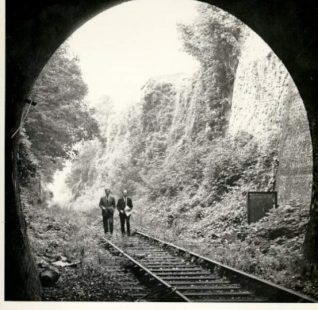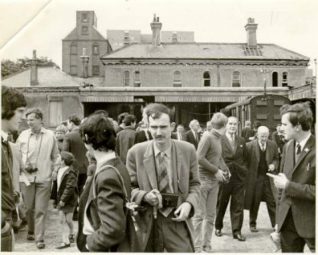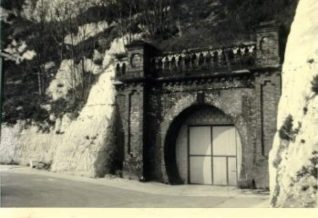Built in 1866-1869



Please note that this text is an extract from a reference work written in 1990. As a result, some of the content may not reflect recent research, changes and events.
Built in 1866-9 by the London, Brighton and South Coast Railway Company under an Act of May 1864, the KempTown branch line was opened principally to fend off a possible rival line into eastern Brighton. The first turf was cut by the mayor, Henry Martin, on 17 February 1866, and the line opened on 2 August 1869. It was a single track, 1 mile 726 yards long, leaving the Lewes line 1,606 yards from Brighton at Kemp Town Junction; the short section from the junction to Lewes Road Station was doubled in July 1895. The journey from Brighton was therefore over 2.3 miles long, about twice the distance by road.
Services were temporarily withdrawn from 1 January 1917 until 10 August 1919, but after attracting some 70,000 to 80,000 passengers annually in the late 1920s, passenger services were permanently withdrawn on 31 December 1932 having been badly affected by competition from buses. The line was then used by goods traffic only and KempTown became the Brighton East goods-depot, but in August 1971 the line finally closed and the goods traffic was transferred to Hove. A final, commemorative, diesel passenger service was run on 26 June 1971; the driver was Stanley Walters who was a hero of the Battle of Monte Casino.
Despite its short length, the line was heavily engineered. The Lewes Road Viaduct, about 180 yards long, carried the track fifty feet above Lewes Road and Melbourne Street, but was demolished in April 1976; the western arches were removed later in 1983 for the new Vogue gyratory road layout and the erection of the Sainsburys superstore. Hartington Road was crossed on a three-arch viaduct (demolished 2 December 1973), and the line then ran through a cutting, now partially filled and levelled as a large recreation ground behind Picton Street, William Clarke Park. Beneath ElmGroveJuniorSchool the line entered the 946-yard Kemp Town Tunnel, to emerge from the chalk cliffs at the northern end of Kemp Town Station yard. From October 1941 until May 1944 the tunnel was used as a store for rail stock and was also made available for use as an air-raid shelter {123}. Part of the tunnel is now used as a mushroom farm, and the almost circular southern portal may still be seen behind the Booker warehouse in Stevenson Road.
Kemp Town Station stood in the former Coalbrook Road, and opened in 1869 with four sidings and one platform, but by 1880 a large goods-yard and coal depot with seventeen sidings had opened. The station building was similar to those at Hove, London Road and Portslade, but nothing now remains of it; the large Freshfield Industrial Estate was opened on the site in June 1974, and by 1987 over 500 people were employed there. Lewes Road Station opened on 1 September 1873 on a site behind the Rediffusion factory in D’Aubigny Road, with another approach via a footpath from Lewes Road. There was a small station building and two platforms connected by a footbridge, but it closed to passengers along with the rest of the line at the end of 1932 and became first a pickle factory and then a builder’s store. The area to the west was used as a goods yard, but the whole site is now occupied by the Centenary Industrial Estate of 1986. Hartington Road Halt was a single platform on the western side of the track just to the south of Hartington Road, and was accessed by a cinder path between Hartington Road and Upper Wellington Road. It opened on 1 January 1906 but closed on 1 June 1911.
Any numerical cross-references in the text above refer to resources in the Sources and Bibliography section of the Encyclopaedia of Brighton by Tim Carder.
The following resource(s) is quoted as a general source for the information above: {7,123,126,176,179,180,187a}




Comments about this page
In 1939 my family had a hotel in Atlingworth Street, and after war was declared in September 1939 we had soldiers billeted on us. I was only 5 and a half in the November but can clearly remember the troops being formed up in Atlingworth Street and marched to Kemptown Station to go off to form part of the British Expeditionary Force sent to France. I watched from the steps of number 6 Atlingworth Street and was then taken to the station to see them off.
I wonder now how many returned via Dunkirk in May 1940. Ken Ross
I remember the old station yards in the fifties. I don’t recall any passenger trains only goods traffic, and I think there was a brewery nearby. I assume they dispatched their traffic by goods train. Did the inwards goods trains, presumably arriving from London etc have a direct route to Kemp Town or did the goods trains have to go into Brighton Station yards and then “run round” for the final run? What a terrible shame the Lewes Road viaduct was dismantled,. Surely someone could have foreseen it would be a grand attraction for tourists, even a tourist railway. I remember as clear as day my dear Dad telling Mum he was off to meet his brother George “underneath the arches” on Lewes Road (I was told he was going to see a man about a dog).What a wonderful website this is, brought back so many happy memories.Congratulations.
Kemp Town railway was only single track from Brighton main station. It had the station at Kemp Town, one at where Sainsbury’s now is and London Road (still there). The line was built at great expense to stop other railways coming in from the East directly along the coast to Brighton. Shrewed move. Under the Arches, where the Viaduct crossed Lewes Road was a rag & bone man. I often took sacks of rags there in exchange for money. Great memories.
Been doing Family History and found out my Great Grandmother Clara Johnston was born at 10 Coalbrook Road in 1857.
I was born in Brighton and lived in Eastern Road, and the Kemp Town Railway was very near. For a while as a child I went to the Pelham Institute Sunday School in Bedford Street. The memory I have of the railway is that every year we had our Sunday School outing and we marched up to the station, boarded the train and either went to Hassocks or Burgess Hill. It was a lovely day out. We had tea in a big hut and played on the swings and slides. It must have been around 1930. My name was Ruby Young. I was born in 1923 and lived in Eastern Road until I was 12yrs old, then moved to Toronto Terrace. Our house on Eastern Road was demolished to widen the road. Ruby Maynard
Ruby, reading your comments bought back memories of stories my Mum told me. She was Irene Page born 1927 in the Hand in Hand pub in Upper St. James’s Street. Every year she too marched up to Kemp Town Railway Station with her Sunday School for outings to either Hassocks or Burgess Hill. The Hassocks venue was the Orchards Pleasure Gardens and Burgess Hill the Victoria Pleasure Gardens where they had a big hut, lots of swings and slides and a huge boating lake. These outings were the highlight of her childhood years and she spoke of them with much fondness. The site of the Orchards Pleasure Gardens is now a housing estate and an industrial estate is now where the Victoria Pleasure Gardens were, the lake having been filled in and built over too.
Suzie, I was so pleased to get a reply as it was so many years ago. I often wondered what happened to both of the gardens, as both towns have grown so much over the years. As I lived in Eastern Road for 12 years from birth, and your mother lived in Upper St James Street, did she go to St Mary’s School as I did? There are many memories of that era.
Ruby, it was nice to read your reply. Yes, my Mum did go to St Mary’s school. She had an older sister called Marjorie and a younger sister called Joyce. All three of them went to St Mary’s. Sadly I lost my Mum just before Christmas. She had a very sharp memory and could easily quote names, teachers, dates, places, events etc. from her childhood. Regarding the Pleasure Gardens, there are two books you may be interested in, by Mark Dudeney and Eileen Hallett and published by Mid Sussex Books:
“Edwin Street and The Victoria Pleasure Gardens”. First published 1997. ISBN 0 9530625 0 3. This book of 80 pages contains a wealth of photographs.
“The Pleasure Grounds of Sussex”. First published 2001. ISBN 0 9530625 1 1.
This book of 95 pages contains 20 pages on The Orchard Pleasure Gardens, 20 pages on The Victoria Gardens and the remaining pages on other pleasure grounds including The Swiss Gardens, The Chinese Gardens and The Devil’s Dyke. This book is also crammed full of photographs. To the best of my knowledge, both books are still in print and can also be borrowed from libraries. If you have difficulty in obtaining them, leave a comment for me on this page. Best wishes, Suzie.
Susie, good news, my daughter- in- law found the book on line and I received it this week. I have started to read it and am enjoying it. The writing is good, not too small, as I have macula and it’s hard to read with very small writing. The pictures are good, I especially remember the boat swings and the ordinary swings with their metal sides, no give as they are now, with chains. About St Mary’s School, I rather think that your mother was there at the same time as me. I also had a sister, two years older than me who also went to St Mary’s. Such a pity through age that there are not many of us left to confer.
Thanks again, RubyQI6
Ruby, I am pleased you have got your book and are enjoying it!
Best wishes
Suzie, I thought I would let you know that I received the other book today, which I am about to read. It looks good and brings back many memories.
Ruby, that’s good news. When I was young my family moved out of Brighton to live very near the site of the Victoria Pleasure Gardens. Although the gardens had long since been shut down, the lake was still there and as a child I spent many a happy hour playing around, and in it! A very tall pole was still in the centre of the lake- thought to support a line of hanging lanterns for winter evening ice-skaters (see photograph). The big wooden Tea Room was still there (being used as a factory) as was the tin bridge, rusted with age, by the waterfall. An old rotten wooden boat remained on the lake until well into the 1960s. The lake was home to swans right up to the day it was filled in.
Best wishes
PS Do you remember the switchback over the lake? That seemed to be everyone’s favourite attraction.
Suzie, funny you should mention the switchback, I have a photo of my Mum and two of my friends’ Mums sliding down the switchback. I wonder who took it. I also think that I had one of the three of them on the donkeys, but can’t find it. The picture inside the Tea Room with the long trestles I remember and the long wooden benches with hordes of children sitting waiting for eats.
I am the daughter of Stanley Walters who was the driver of the final diesel passenger service in 1971. I remember that day so clearly now, I was allowed to ‘go up front’ with my father after the train had completed its journey. Thank you for reminding me of that very special day.
I was born and grew up in Brighton and lived opposite London Rd Station. I was always fascinated by the tracks that went over the Lewes Rd. viaduct, the tunnel the tracks went through and where they ended up in Kemp Town. I watched a documentary recently on the history of the movies. Brighton featured prominently in the early days of motion pictures and, if memory serves me, the first ever moving camera shot was taken from the front of a steam engine making its way from Kemp Town Station to Brighton.
Hello Phil, Good to see all your new comments. Hope you are well out there in all that Arizona sunshine! I wondered if you have a link to the documentary on the history of the movies which includes the shot taken from the front of a steam engine making its way from Kemp Town Station to Brighton? Maybe you’d post it up here for us all to peek at.
Best wishes from Snowy Scotland.
Unusually, on a Good Friday, I walked the Kemp Town branch with good friend Vic Chapman (also of Woodingdean). The tunnel is not lined above – the side walls only go up to about shoulder height. Chalk is very stable. We did a later walk with Davey Crockatt and took photos inside. There was a three-way point in the tunnel mouth at Kemp Town. On the last day, we travelled in one of the DMU’s that ferried us back and forth between the terminus and Brighton Station. We saw the very last train, took photos at Kemp Town, then drove with some, erm, determination across town to Hartington Road. I was leading in my Austin Maxi, and Vic in his A35 chickened out of the fast turn off Elm Grove just below the school. I was able to climb the embankment and get a photo in the dusk of train number “99” (shades of Barbara Feldon?) as it exited the tunnel and crossed the viaduct, the last passenger train to do so. Happy days. I must find the photographs, and see if I can get them posted. Cheers, Geoff. Johnson
Add a comment about this page